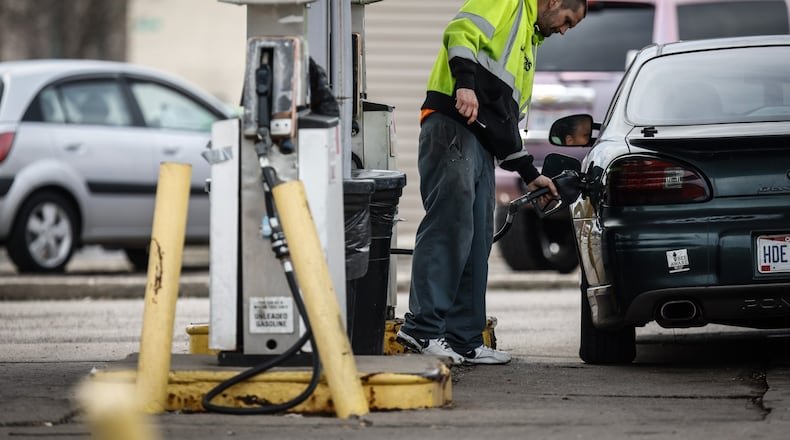“Any downturns will likely relegated to short-term decreases and that’s where we are now,” Patrick De Haan, head of petroleum analysis for GasBuddy, said. The price of a barrel of crude oil, after having fallen under a $100, I think it was $98, now we’re back up to $115, so unfortunately I think it’s just a matter of time before Dayton goes back above that $4 a gallon average ... and that could happen potentially today, tomorrow or early next week.”
Stations already are paying higher prices for wholesale, almost 20 cents a gallon over the past several days, but have yet to pass on that cost increase to motorists.
De Haan, who regularly looks at a variety of factors to help forecast where gas prices are heading, said “for once in my career, it’s not a question of what I see.”
“Russia-Ukraine, there is just a level of unpredictability there with what Putin may do,” he said. “If nothing changes for the worse between now and then, I think we’ll see prices dancing around the $4 mark most of the summer, but something’s going to change. It’s just a matter of when, not if, and that’s what worries me.
It becomes increasingly difficult to see where prices are headed because Russian is “an energy super power” and “the goal posts are moving on a daily basis as this situation develops,” he said.
“As long as Russia is fighting a war against Ukraine, oil and gas prices will remain elevated,” De Haan said. “If the situation worsens, if it escalates, prices are going to go up.”
If it de-escalates, eventually prices may go down, but the question is now, ‘Is Russia tarnished? Can anyone trust them?’” he said. “Even if there is a peace treaty signed, I don’t think the world is going to flock back to doing business with Russia, so I think this is a long-sum game. I don’t think we’re going to get out of this with much relief for a while.”
Tim Snyder, an economist with Dallas-based Matador Economics, said gas prices staying high goes beyond geopolitical issues and supply not recovering to meet demand.
“The U.S. government is making it difficult for the exploration production companies to produce,” he said.
In additions, gas stations are transitioning to the more expensive, EPA-required summer blend of gasoline, which creates less fluorocarbons and less opportunity for greenhouse gas emissions and smog.
“That’s about 18 to 22 cents a gallon more expensive than the winter blends,” he said. “We won’t transition back to that until September.”
Price increases should arrive by the end of the month, Snyder said.
For the sixth consecutive week, there was no increase in crude oil production in the United States, according to U.S. Energy Information Administration (EIA).
“We’re still stuck at 11.6 million barrels per day and that tells me this will continue until we start seeing increases in the amount of crude oil that we’re pulling out of the earth and sending to refineries,” Snyder said.
U.S. oil production remains bottlenecked by supply challenges, not policies, and that’s the challenge, De Haan said.
“If oil companies wanted to drill, there are so many headwinds right now to prevent them from doing it,” he said. “Labor challenges, fuel shortages, well-head shortages. There’s not a shortage of permits, but there’s a shortage of basically everything else that it takes to drill for oil right now. We’re seeing that across the economy. Whether it’s a shortage of this or that, the pandemic is really the culprit for a lot of these imbalances. If it wasn’t for COVID, we’d be in a much different spot. We could probably respond quicker, but a lot of business and investments shrunk because of COVID and so it’s taking more time to get things back up to where they need to be.”
Additionally concerning is the continuous drop of the Strategic Petroleum Reserve as the Biden Administration attempts to appease some markets, but without any effect on the price of gas, he said.
According to new data from the EIA, total domestic gasoline stocks fell by 3 million barrels to 238 million barrels between March 13 and March 19. Gasoline demand also decreased from 8.94 million barrels per day to 8.63 million barrels per day. “The drop in gas demand is contributing to price decreases,” AAA said. “However, the steady increase in the price of oil is slowing that decline. If oil prices continue to rise, pump prices will likely follow suit, reversing course from the current downward trend.”
AAA Club Alliance spokeswoman Kara Hitchens said AAA calls for emergency roadside service increased 20 percent in recent weeks compared to this time last week.
“It shows us that people are putting off buying gas for whatever reason,” she said. “Can we exactly say that it’s because of fuel prices? We cannot, but if you’re drawing that correlation, it’s easy to make those assumptions and make that analogy to say that it’s probably related to putting off buying new gas.”
Those who call for ERS receive enough gas to get them to a local station, either for free or for the cost of the gas itself depending on one’s membership level, Hitchens said.
About the Author

